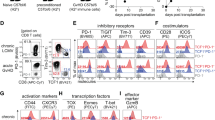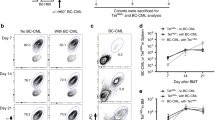Abstract
Tumor necrosis factor (TNF)-related apoptosis-inducing ligand (TRAIL) is a member of the TNF superfamily that exhibits specific tumoricidal activity against a variety of tumors1,2. It is expressed on different cells of the immune system and plays a role in natural killer cell–mediated tumor surveillance3,4,5. In allogeneic hematopoietic-cell transplantation, the reactivity of the donor T cell against malignant cells is essential for the graft-versus-tumor (GVT) effect6. Cytolytic activity of T cells is primarily mediated through the Fas–Fas ligand and perforin–granzyme pathways. However, T cells deficient for both Fas ligand and perforin can still exert GVT activity in vivo in mouse models7,8. To uncover a potential role for TRAIL in donor T cell–mediated GVT activity, we compared donor T cells from TRAIL-deficient and wild-type mice in clinically relevant mouse bone-marrow transplantation models. We found that alloreactive T cells can express TRAIL, but the absence of TRAIL had no effect on their proliferative and cytokine response to alloantigens. TRAIL-deficient T cells showed significantly lower GVT activity than did TRAIL-expressing T cells, but no important differences in graft-versus-host disease, a major complication of allogeneic hematopoietic cell transplantation, were observed. These data suggest that strategies to enhance TRAIL-mediated GVT activity could decrease relapse rates of malignancies after hematopoietic cell transplantation without exacerbation of graft-versus-host disease.
This is a preview of subscription content, access via your institution
Access options
Subscribe to this journal
Receive 12 print issues and online access
$209.00 per year
only $17.42 per issue
Buy this article
- Purchase on Springer Link
- Instant access to full article PDF
Prices may be subject to local taxes which are calculated during checkout



Similar content being viewed by others
Change history
16 October 2002
In the version of this article originally published online, Figure 2b contained an error: C57BL/ should be C57BL/6. This has been corrected in the HTML and PDF versions, and will appear correctly in the forthcoming print issue.
Notes
Note: In the version of this article originally published online, Figure 2b contained an error: C57BL/ should be C57BL/6. This has been corrected in the HTML and PDF versions, and will appear correctly in the forthcoming print issue. We regret this error.
References
Wiley, S.R. et al. Identification and characterization of a new member of the TNF family that induces apoptosis. Immunity 3, 673–682 (1995).
Walczak, H. et al. Tumoricidal activity of tumor necrosis factor-related apoptosis- inducing ligand in vivo. Nature Med. 5, 157–163 (1999).
Takeda, K. et al. Involvement of tumor necrosis factor-related apoptosis-inducing ligand in surveillance of tumor metastasis by liver natural killer cells. Nature Med. 7, 94–100 (2001).
Smyth, M.J. et al. Tumor necrosis factor-related apoptosis-inducing ligand (TRAIL) contributes to interferon gamma-dependent natural killer cell protection from tumor metastasis. J. Exp. Med. 193, 661–670 (2001).
Kayagaki, N. et al. Type I interferons (IFNs) regulate tumor necrosis factor-related apoptosis-inducing ligand (TRAIL) expression on human T cells: A novel mechanism for the antitumor effects of type I IFNs. J. Exp. Med. 189, 1451–1460 (1999).
Appelbaum, F.R. Haematopoietic cell transplantation as immunotherapy. Nature 411, 385–389 (2001).
Winter, H., Hu, H.M., Urba, W.J. & Fox, B.A. Tumor regression after adoptive transfer of effector T cells is independent of perforin or Fas ligand (APO-1L/CD95L). J. Immunol. 163, 4462–4472 (1999).
Braun, M.Y., Lowin, B., French, L., Acha-Orbea, H. & Tschopp, J. Cytotoxic T cells deficient in both functional fas ligand and perforin show residual cytolytic activity yet lose their capacity to induce lethal acute graft-versus-host disease. J. Exp. Med. 183, 657–661 (1996).
Jeremias, I., Herr, I., Boehler, T. & Debatin, K.M. TRAIL/Apo-2-ligand-induced apoptosis in human T cells. Eur. J. Immunol. 28, 143–152 (1998).
Mariani, S.M. & Krammer, P.H. Surface expression of TRAIL/Apo-2 ligand in activated mouse T and B cells. Eur. J. Immunol. 28, 1492–148 (1998).
Schmaltz, C. et al. Differential use of Fas ligand and perforin cytotoxic pathways by donor T cells in graft-versus-host disease and graft-versus-leukemia effect. Blood 97, 2886–2895 (2001).
Ashkenazi, A. et al. Safety and antitumor activity of recombinant soluble Apo2 ligand. J. Clin. Invest. 104, 155–162 (1999).
Ichikawa, K. et al. Tumoricidal activity of a novel anti-human DR5 monoclonal antibody without hepatocyte cytotoxicity. Nature Med. 7, 954–960 (2001).
Jo, M. et al. Apoptosis induced in normal human hepatocytes by tumor necrosis factor–related apoptosis-inducing ligand. Nature Med. 6, 564–567 (2000).
Lawrence, D. et al. Differential hepatocyte toxicity of recombinant Apo2L/TRAIL versions. Nature Med. 7, 383–385 (2001).
Hattori, K. et al. Differential effects of anti-Fas ligand and anti-tumor necrosis factor alpha antibodies on acute graft-versus-host disease pathologies. Blood 91, 4051–4055 (1998).
Van den Brink, M.R. et al. Fas-deficient lpr mice are more susceptible to graft-versus-host disease. J. Immunol. 164, 469–480 (2000).
Bordignon, C. et al. Graft failure after T-cell-depleted human leukocyte antigen identical marrow transplants for leukemia: II. In vitro analyses of host effector mechanisms. Blood 74, 2237–2243 (1989).
Cretney, E. et al. Increased susceptibility to tumor initiation and metastasis in TNF-related apoptosis-inducing ligand-deficient mice. J. Immunol. 168, 1356–1361 (2002).
Sedger, L.M. et al. Characterization of the in vivo function of TNF-alpha-related apoptosis-inducing ligand, TRAIL/Apo2L, using TRAIL/Apo2L gene-deficient mice. Eur. J. Immunol. 32, 2246–2254 (2002).
Matulonis, U., Salgia, R., Okuda, K., Druker, B. & Griffin, J.D. Interleukin-3 and p210 BCR/ABL activate both unique and overlapping pathways of signal transduction in a factor-dependent myeloid cell line. Exp. Hematol. 21, 1460–146 (1993).
Cooke, K.R. et al. An experimental model of idiopathic pneumonia syndrome after bone marrow transplantation: I. The roles of minor H antigens and endotoxin. Blood 88, 3230–3239 (1996).
Crawford, J.M. Graft-versus-host disease of the liver. in Graft-Versus-Host-Disease (eds. Ferrara, J.L.M., Deeg, H.J. & Burakoff, S.J.) 315–336 (Marcel Dekker, New York, 1997).
Ferrara, J., Guillen, F.J., Sleckman, B., Burakoff, S.J. & Murphy, G.F. Cutaneous acute graft-versus-host disease to minor histocompatibility antigens in a murine model: Histologic analysis and correlation to clinical disease. J. Invest. Dermatol. 86, 371–375 (1986).
Acknowledgements
We thank the staff of the Research Animal Resource Center for animal care; M.-A. Perales for assistance with intracellular cytokine staining; H. Nguyen for expertise with the histopathologic examination of tissue specimen; G. Heller for statistical help; and R.J. O'Reilly and A. Houghton for helpful discussions and support throughout the project. This work was supported by grants HL69929 and HL72412 from the National Institutes of Health (to M.R.M.v.d.B.). C.S. is a Special Fellow of the Leukemia and Lymphoma Society. M.R.M.v.d.B. is the recipient of a Damon Runyan Scholar Award of the Cancer Research Fund and a research award from the V scholar program of the V Foundation.
Author information
Authors and Affiliations
Corresponding author
Ethics declarations
Competing interests
J.J.P. is a shareholder in the Amgen Corporation.
Rights and permissions
About this article
Cite this article
Schmaltz, C., Alpdogan, O., Kappel, B. et al. T cells require TRAIL for optimal graft-versus-tumor activity. Nat Med 8, 1433–1437 (2002). https://doi.org/10.1038/nm1202-797
Received:
Accepted:
Published:
Issue Date:
DOI: https://doi.org/10.1038/nm1202-797
This article is cited by
-
Donor CD19 CAR T cells exert potent graft-versus-lymphoma activity with diminished graft-versus-host activity
Nature Medicine (2017)
-
[ 18 F]FHBG PET/CT Imaging of CD34-TK75 Transduced Donor T Cells in Relapsed Allogeneic Stem Cell Transplant Patients: Safety and Feasibility
Molecular Therapy (2015)
-
BCR-ABL regulates death receptor expression for TNF-related apoptosis-inducing ligand (TRAIL) in Philadelphia chromosome-positive leukemia
Oncogene (2013)
-
Oncogenic fusion E2A-HLF sensitizes t(17;19)-positive acute lymphoblastic leukemia to TRAIL-mediated apoptosis by upregulating the expression of death receptors
Leukemia (2012)
-
Resistance of MLL–AFF1-positive acute lymphoblastic leukemia to tumor necrosis factor-alpha is mediated by S100A6 upregulation
Blood Cancer Journal (2011)



